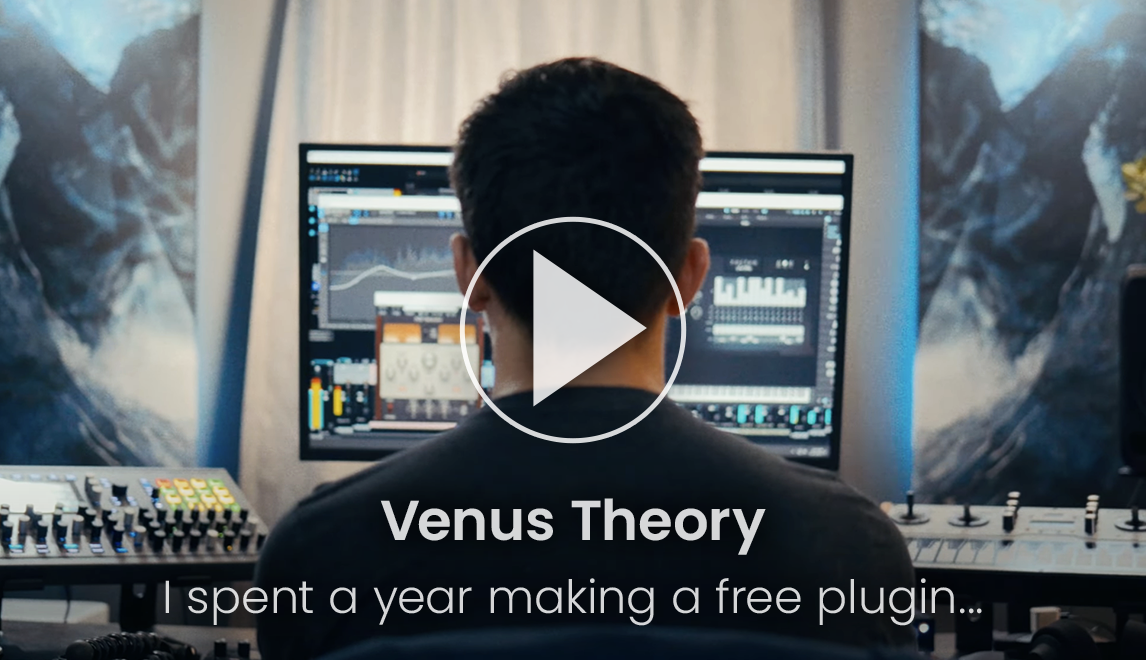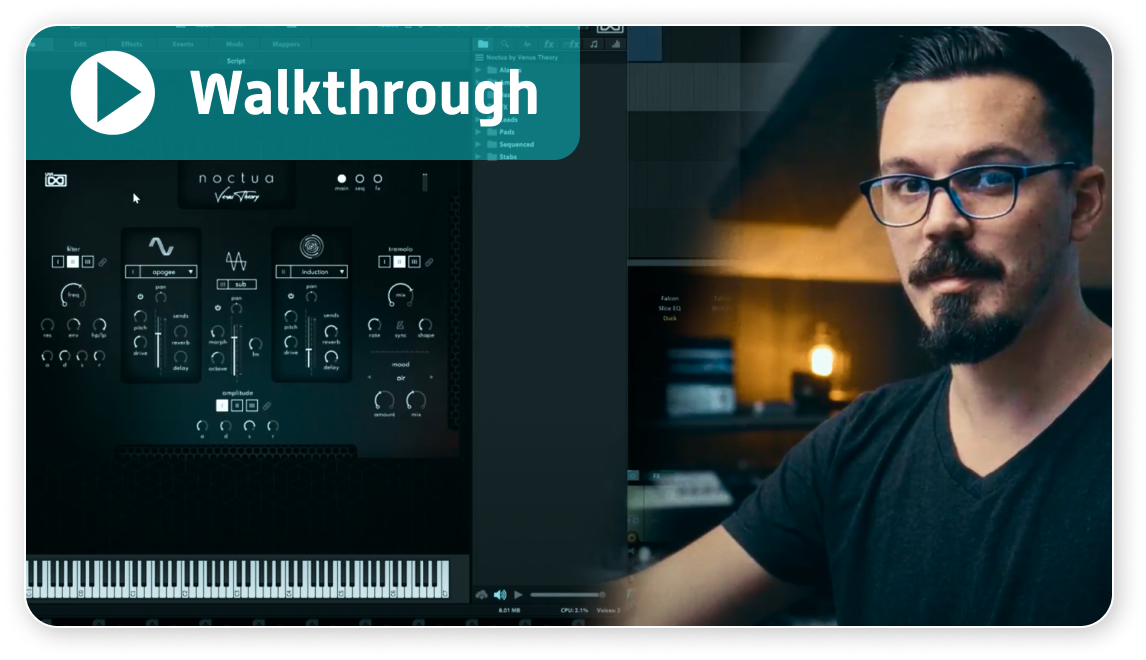

My name is Cameron, but I'm better known as Venus Theory (or so I like to tell myself). I'm a sound designer, musician, and YouTube creator based outside of Nashville, Tennessee and my day-to-day work usually consists of a bit of a mix of all of the above.
I've worked with lots of hardware and software companies for things like preset design and expansion packs, content creation, demo tracks and sample/loop kits over the years. I also do a fair bit of com-
posing work for things like games and films and library music, as well as sound design and FX design for stuff like asset packs and trailer libraries. In between, I run my YouTube channel (also under Venus Theory) where these days I mostly make videos focused on the psychology and philosophy of creative work.
Musically and sonically, I'd say I specialize mostly in the realms of trailer/game music and underscore type work with a focus on contemporary electronic ideas with a dark ambient sort of tinge and a lot of 'hybrid' work by integrating lots of different sonic textures and manipulated acoustic and organic elements into my work.
Long story short: I'm an absolute sound and video nerd who plays too much video games, and it eventually turned out that can all actually be a valuable set of life skills that results in a career.

Falcon is one of my favorite tools in the studio! Whenever I need something involving sampling, Falcon is generally my go-to platform. With the mix of different sampling engines and the synthesis engines you can use to supplement a patch, the walls of FX on offer, and all the crazy layering and MPE abilities there's really nothing that's quite as versatile for sound design and composition.
For my sound design work, Falcon is one of my main sample mangling tools thanks to the different engines it can offer and with the new template options added in V3 it's become even more useful to have a set of custom tools for mangling different sounds and ideas to create new one shots and sample based ideas.
With music work, Falcon has a massive amount of content available with all the different expansions and soundwares but being able to use the UVI Soundware offerings within it as well is amazing. It makes it easy to prototype my own sample instrument creations for scoring work, and it makes it equally easy to deep-dive into my favorite soundwares to add new features or change things up under the hood with new sequencers or FX chains and such.
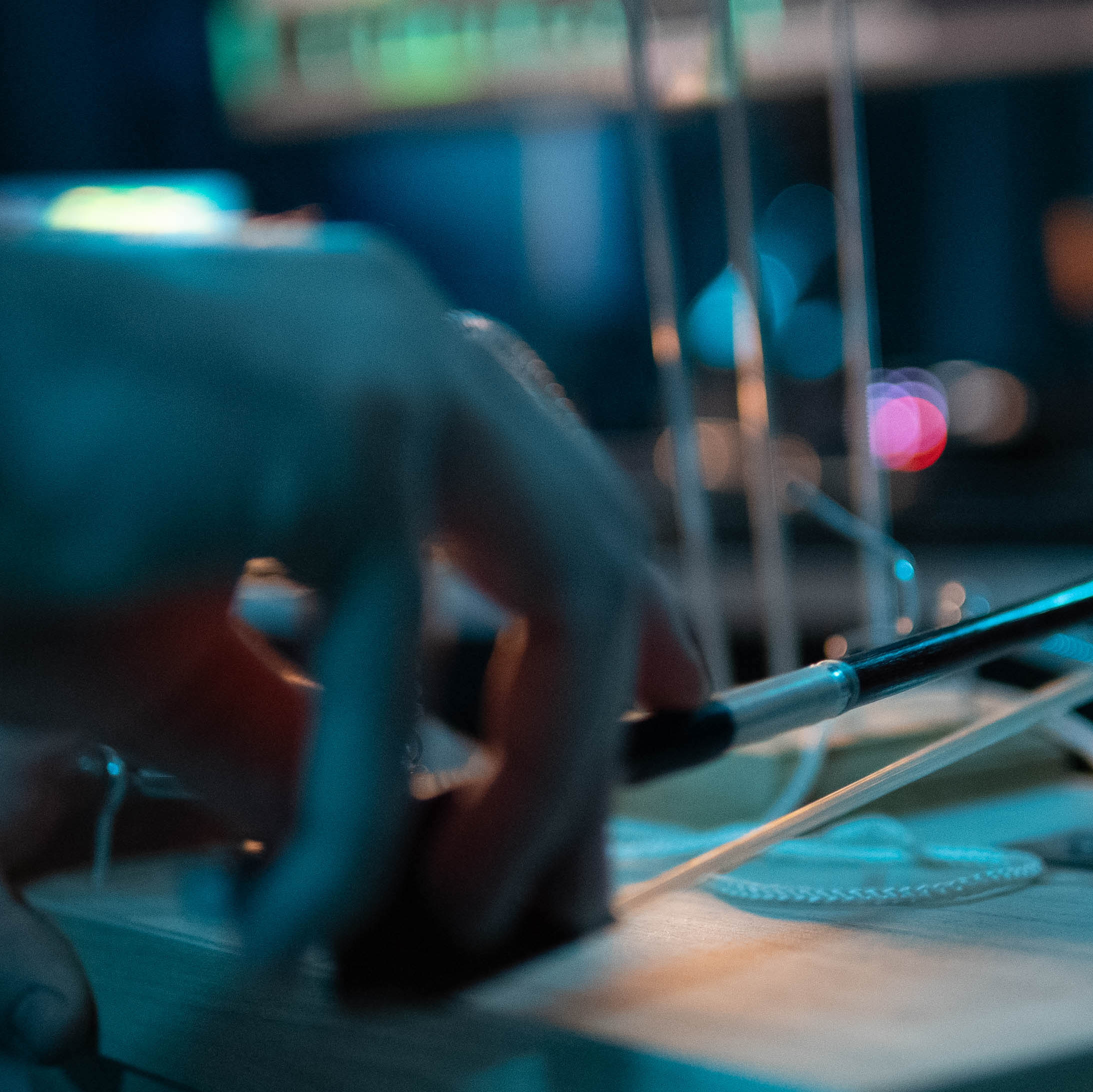
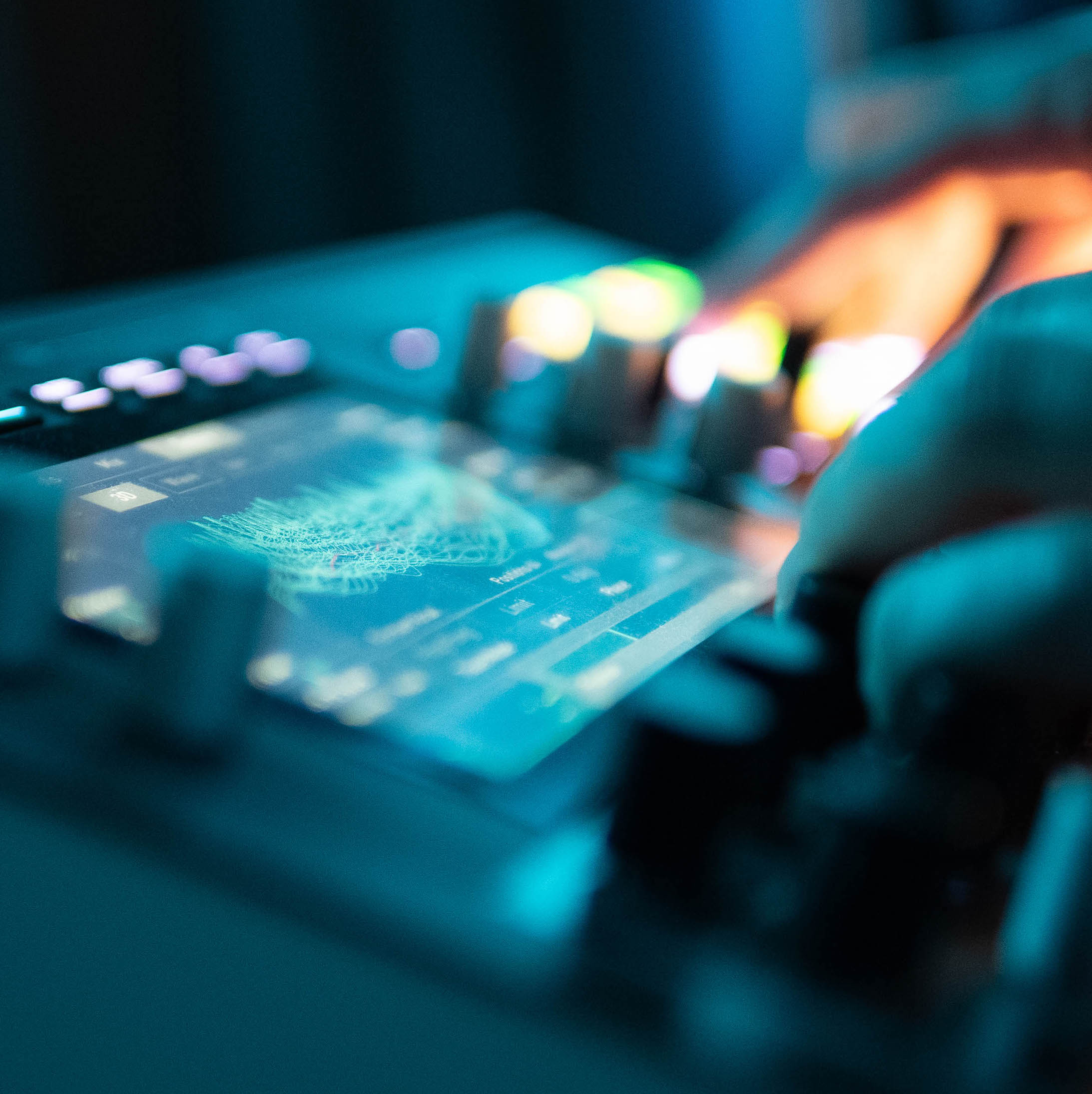
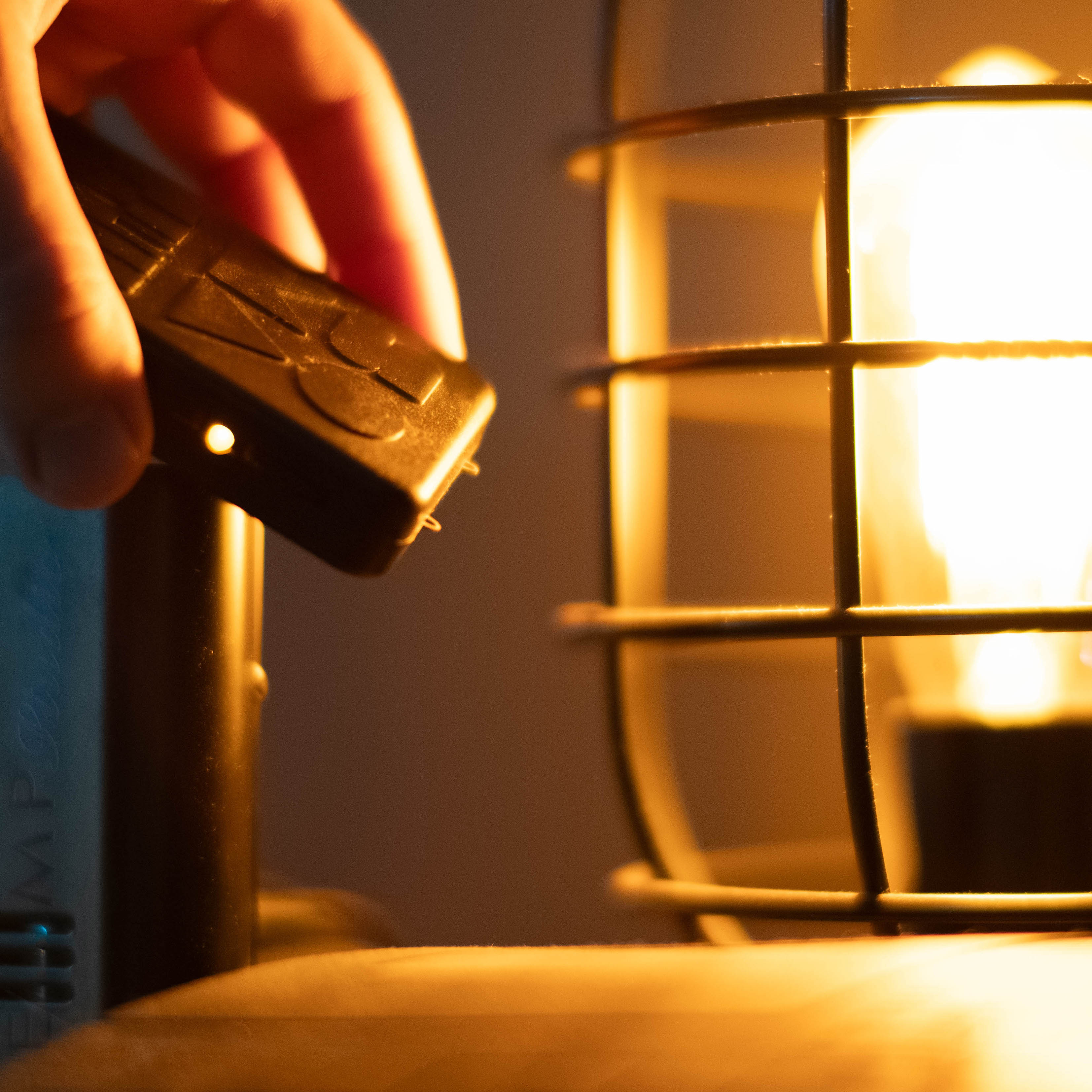
Noctua started out as an idea for one of my own sample based instruments - I was looking to create some kind of 'signature palette' of my usual sounds and ideas as a timesaving effort for my own music and scoring work.
After a few prototypes, it became pretty clear to me that the idea I had was just beyond my own capabilities to program and put together inside of Falcon (or any other platform for that matter).
At NAMM 2023, I brought up the idea to the UVI team and they were kind enough to help me put the whole thing together since they thought it was also an idea that would work as a cool new product in their soundware lineup - that is to say the stars aligned to where I basically got to do all the fun stuff, and they had to do all the heavy lifting to slap my ideas together haha.
In early 2023 I had developed a few prototype instruments by sampling out various components that would make up what eventually would become Noctua. The original project was significantly larger and more scatterbrained, but eventually I was able to dial things down a bit into a handful of key components and sound types.
The initial vision was around 10-15 different categories and sources, but that's a massive amount of work to take on as a solo project and also means the resulting library (at least in my mind) seems a bit unfocused and puts too much work on the user to 'make their own fun' so to speak and not everyone is really into that sort of thing.
After NAMM, the UVI team was able to help me refine the idea further down to just the 3 key categories of sounds which made the sampling process much more manageable and in turn made the library a lot more immediate and useful.
In my home studio, I recorded and edited all of the samples and then worked out the basic layout and sound engine features of the soundware. Once that was in place, the UVI team took over finalizing the UI and controls, as well as adding in some extra features that they had in mind that I think really brought out even more potential in the soundware than I had originally envisioned.
When all that was wrapped up, I got to stop by the offices in Paris (which it turns out is a looooooong way from Nashville) and work with the team to finalize things like the UX/UI, work on presets, and sit down and figure out all the promotion and marketing assets. Then it was back home to work on the trailer cue and now here we are!
Noctua is built up of three main categories - Analog, FX Box, and EMF.
The Analog soundset was captured from a variety of analog synthesizers and a few digital synthesizers that were processed with lots of different boutique pedals to create big 'staple' sounds that serve as the core basis for the library without being overly traditional analog style textures. I wanted these samples to have a more stable 'core' feeling, while still having a lot of mood and texture that was a but more evocative than just saw waves and such.
The FX Box category was created using my homemade FX Box instruments. These are built out of scrap hardware parts and different wooden boxes and then wired up with contact microphones. They're a lot of fun to play with because you can hit them, strike them with different mallets and objects, bow them, flick the springs, and all sorts of other 'techniques' to produce some insane sounds and one-shots. These are especially fun when recorded at high sample rates and pitched down or when processed with weird FX chains.
To turn those into a set of multisamples was a bit of a challenge, since the one shots are just one shots and they aren't necessarily tonal sounds. Instead, after spitballing some ideas with the UVI team I was able to find a process using combinations of granular synthesis and some different FX chains to create sounds that could be mapped as a multisample to offer a lot of different moods and textures that pair nicely with the other two categories.
Finally the EMF section of sounds was created using the SOMA Ether - a really interesting microphone that picks up the sounds of electricity. This was a lot of fun, and a lot of frustration at the same time since every single electric item makes a unique sound but not all of them were necessarily usable. I went all throughout my house, down to to the city, around different stores, and anything else that seemed interesting that was powered with electricity.
The resulting sampleset was MASSIVE since I had to record very long samples to have enough material to manipulate in the DAW to turn them into multisamples since each source only produced one tone. Turns out you can't really ask a lightbulb to give you a G3.
The final result is a combination of a few different processes, but mostly manipulating the recorded sounds with a combination of FM and RM to create stable and predictable pitches that have loads of crackly texture and movement that adds a ton of vibe!
Like I said earlier - Noctua was basically envisioned as a 'Venus Theory In A Box' sort of thing since I wanted a utility soundset that would work well with my own music and scoring work. I love developing my own sampled instruments and I have dozens of them that I've saved just for my personal vault, and it's a great way to have that unique set of tools and ideas that makes your music your own.
I really wanted to capture the sort of liminal, dark, and moody underscore feel that also could work in the context of more intense 'trailer-ified' sounds and action scores, and something that could just act as either a 'finishing touch' to add some texture and character to a piece or something that could be a unique identity statement.
The UVI Team was really helpful in taking that idea so much further though - they asked for some custom FX chains to modify the sounds, added in lots of cool under-the-hood enhancements and tricks, and even implemented the tri-layer microtonal sequencer which was well beyond what I ever had in mind and it turned into something that I think is a lot more interesting.
Given that it's a sort of embodiment of my favorite sounds and ideas, I'm excited to see it revamped into this new context thanks to the UVI team and I'm really excited to see what others are able to make with it. Since the folks at UVI were able to add so much more to my (admittedly chaotic) idea, I'm really interested to see how others are able to turn the sounds from this library into something that's entirely their own!
UVI Focus
- UVI Focus - Throwback 2025 - Sometimes, we just want to rewind
- UVI Focus - Augmented Choirs: A Vocal Odyssey Between Tradition and Innovation
- UVI Focus - Creating Immersive Experiences: The Power of Post Production and Foley Sound Design
- UVI Focus - Behind the Sound: The approach powering SonicBundle
- UVI Focus - In conversation with Tonnerre
- UVI Focus - Discover 5 reasons why you need Mosaiq
- UVI Focus - A look at our most celebrated products
- UVI Focus - Rediscover iconic sounds with Doctor Mix
- UVI Focus - Throwback 2024, a year of releases
- UVI Focus - The Art of Tape: Tape Suite and the Revival of analog Techniques
- UVI Focus - Exploring the legends behind Quadra Modular
- UVI Focus - When Creativity Meets Innovation
- UVI Focus - Key Suite's 5 Rare & Unconventional Machines
- UVI Focus - In Conversation with Jean-Claude Chapuis
- UVI Focus - In Conversation With Venus Theory
- UVI Focus - HX-20: Reviving the MS-20 inspiration in 5 timeless tracks
- UVI Focus - In Conversation With Jon Carin
- UVI Focus - 2023 Throwback - A year of inspiration
- UVI Focus - 10 Falcon Power-Features You Should Know
- UVI Focus - Soul Bass & Soul Drums: A Dynamic Duo
- UVI Focus - Synth Anthology 4 - Experiencing Sound Design with MPE
- UVI Focus - The story of KAWAI
- UVI Focus - In Conversation With Antoine Martin
- UVI Focus - Advanced Sound Design Techniques with Falcon Expansions
- UVI Focus - Phasor: The Story of a Mythical Effect
- UVI Focus - 5 Key Features of Percussion Factory 2
- UVI Focus - The story of Vintage Vault 4
- UVI Focus - In Conversation With Lou Wiss
- UVI Focus - 7 Hidden Gems of Toy Suite
- UVI Focus - PX Guitar Syn, A Piece of Hybrid-Instrument History
- UVI Focus - In conversation with Jordan Rudess
- UVI Focus - IRCAM & UVI, a successful pair
- UVI Focus - Behind-the-scenes of Soul Drums
- UVI Focus - Deep Dive into Synth Anthology 4's modular rarities
- UVI Focus - Deep dive in Falcon's 'Texture' Oscillator
- UVI Focus - In conversation with Simon Stockhausen
- UVI Focus - Deep dive in World Suite 2's Oriental Ensemble
- UVI Focus - Exploring Key Suite Bundle Edition
- UVI Focus - Behind-the-scenes of Walker 2
- UVI Focus - In action with Dual Delay X
- UVI Focus - In action with Shade
- UVI Focus - In conversation with Guillaume Roussel
- UVI Focus - Behind-the-scenes of Augmented Orchestra
- UVI Focus - Behind-the-scenes of UVI



